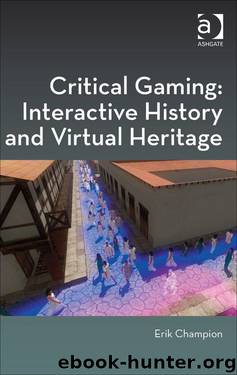Critical Gaming: Interactive History and Virtual Heritage (Digital Research in the Arts and Humanities) by Professor Erik Champion

Author:Professor Erik Champion [Champion, Professor Erik]
Language: eng
Format: epub
Publisher: Ashgate Publishing Ltd
Published: 2015-09-27T21:00:00+00:00
Meaningful Interaction is Meaningful Learning
In the following chapters, I will examine issues of rituals and role-playing, and violence, but I will make the controversial suggestion that there are not many developed examples of virtual heritage projects addressing these issues because such projects typically do not have advanced thematic interaction. And I am not alone in this view – Maria Roussou decried the current state of meaningful interaction and learning in virtual reality (2005, p. 94):
To summarize, VR projects developed for museums or other, research-based educational VR studies have either not provided the analytical evidence to demonstrate learning or, where an educational impact was perceived, there is no explanation of how and why. And more importantly, the role of interactivity within learning has not been the focus of any of the evaluations carried out. Hence, the research question that emerges is how interactivity in a virtual learning environment can influence learning.
Whether cultural presence is transmitted via reading a palimpsest or by participating on a social stage, one must bear in mind that it can be perceived from the outside (etic cultural presence) or lived from the inside (emic cultural presence). Interaction is crucial in the creation of culture and, by extension, in the understanding of culture.
Games have the ability to synthesize narrative, conjecture, computer-generated objects, contextually constrained goals, real-time dynamic data and user-based feedback (Mateas and Stern, 2003). Through this interactive richness (rather than through a high-tech ability to reproduce elements of the real world), people can both learn and enjoy alterity (experience of the ‘other’). In a virtual heritage environment, the more one can master local cultural behaviour, the more one can understand significant events from the local cultural perspective. Mastery of dialogue and artefact use, as viewed from a local cultural perspective, may lead to enhanced cultural immersion and may consequently lead to a heightened sense of engagement.
Is it useful, desirable or even possible to interact with digital reconstructions of different cultures in a meaningful way? Could interaction actually interfere with the learning process? According to Black (2001), research has suggested that children desire interaction and personalization in museum exhibits, but others have suggested that successful cases of ‘edutainment’ are far too rare (Papert, 1998).
If we do manage to create an engaging and believable virtual environment, will the novelty or entertainment value actually interfere with the cultural understanding gained by the users? Sceptics may argue that an attempt to make the experience engaging by looking at game design hinders the cultural learning experience, damages actual historical learning and creates a false sense of authenticity. It is also possible that attempting to create contextual affordances and constraints will put too heavy a cognitive load on the audience or require a high degree of skill and a large amount of time immersed in a virtual environment. In virtual heritage environments, this is particularly evident in the conflict between individual freedom to explore and the more pragmatic need to convey historical information. For example, we may create an entertaining game, yet, however
Download
This site does not store any files on its server. We only index and link to content provided by other sites. Please contact the content providers to delete copyright contents if any and email us, we'll remove relevant links or contents immediately.
Aircraft Design of WWII: A Sketchbook by Lockheed Aircraft Corporation(32197)
The Great Music City by Andrea Baker(31264)
Call Me by Your Name by André Aciman(20357)
The Secret History by Donna Tartt(18821)
The Art of Boudoir Photography: How to Create Stunning Photographs of Women by Christa Meola(18511)
Shoot Sexy by Ryan Armbrust(17641)
Plagued by Fire by Paul Hendrickson(17322)
Portrait Mastery in Black & White: Learn the Signature Style of a Legendary Photographer by Tim Kelly(16939)
Adobe Camera Raw For Digital Photographers Only by Rob Sheppard(16888)
Photographically Speaking: A Deeper Look at Creating Stronger Images (Eva Spring's Library) by David duChemin(16605)
Ready Player One by Cline Ernest(14502)
Pimp by Iceberg Slim(14338)
Bombshells: Glamour Girls of a Lifetime by Sullivan Steve(13958)
The Goal (Off-Campus #4) by Elle Kennedy(13496)
Art Nude Photography Explained: How to Photograph and Understand Great Art Nude Images by Simon Walden(12958)
Kathy Andrews Collection by Kathy Andrews(11715)
The Priory of the Orange Tree by Samantha Shannon(8873)
The remains of the day by Kazuo Ishiguro(8800)
Thirteen Reasons Why by Jay Asher(8775)
